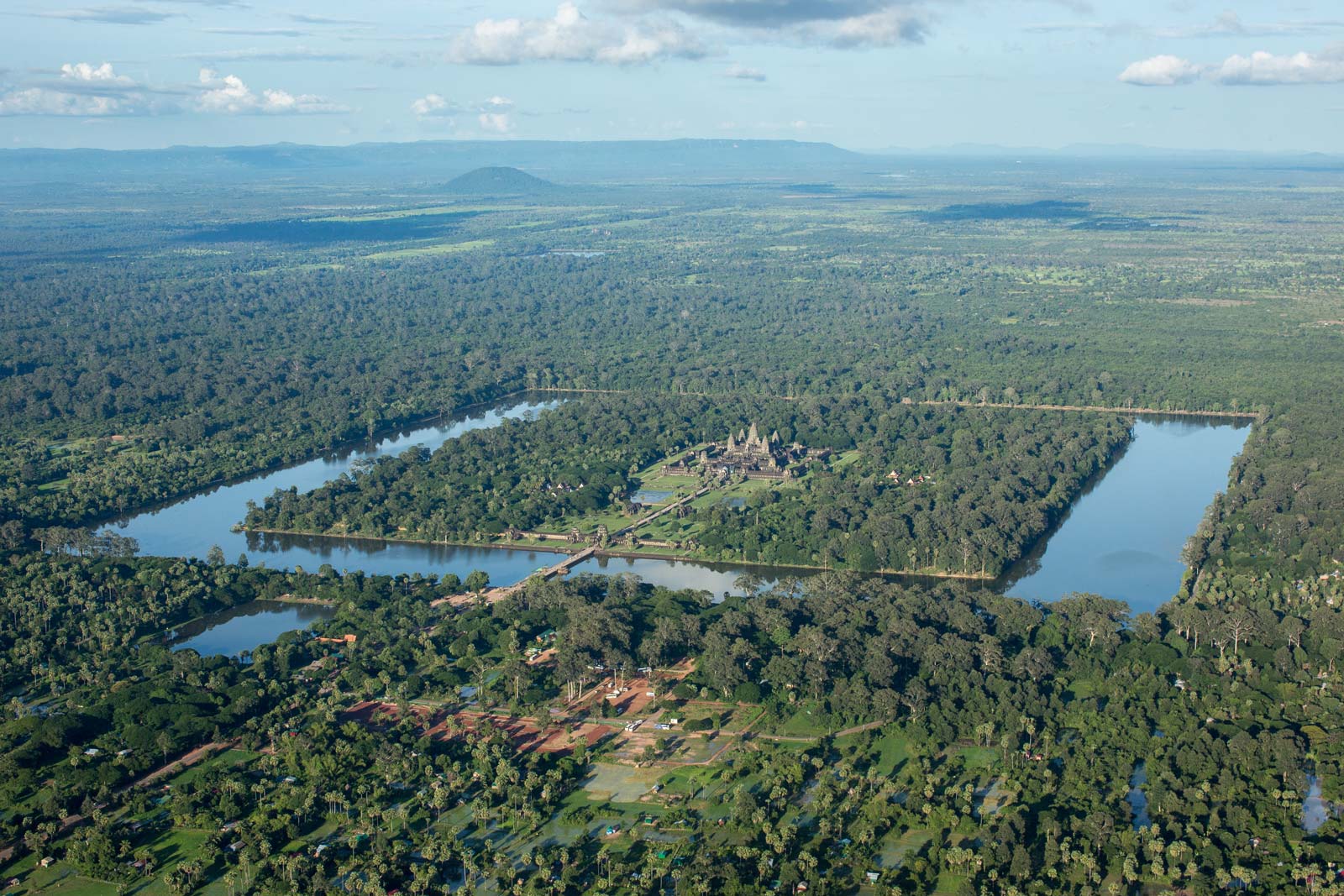Editors note: On 14 December 1992, UNESCO listed Angkor Wat as a World Heritage Site at the 16th session of the World Heritage Committee. Surviving the chaos of the 1970s relatively unscathed – not least the Khmer Rouge era between 1975-79 – the precarious nature of preserving this great wonder became apparent during the 1980s, as art thieves working out of Thailand claimed almost every head that could be lopped off the structures in the complex. Today, 27 years on, Angkor Wat is among the world’s most visited attractions, but its relevance extends beyond mere tourism. In this piece from October 2018, we look at what modern cities – increasingly vulnerable to the effects of climate change – can learn from the climate crisis that contributed to the collapse of the great civilisation once housed in this ancient wonder.
Through dense foliage, five spires pierce the forest canopy, exalting the presence of a longstanding man-made structure. Beneath the trees, a temple: walls imbedded with stone effigies, pathways leading to sheltered galleries, and a serene moat carved around the entire complex. Moss, lichen and roots have crept in over time to cover and crack the stone structures, and still the temple stands.
This is Angkor Wat: a cornerstone of Cambodian culture and history that has endured for more than 800 years. Though it is now one of a handful of temples still standing in the forests north of Siem Reap, Angkor Wat once stood at the heart of a sprawling metropolis home to more than 750,000 people.
The Khmer Empire was the most sophisticated and prosperous kingdom in preindustrial Southeast Asia, and the city of Angkor was its most developed metropolis. First founded in the 900s, the capital grew and flourished over time to become the world’s largest city at the turn of the 13th century. With its terraces, pools and palaces, the city’s immense size rivalled that of present-day cities like Los Angeles and Berlin.
But the prosperity did not last. A recent report published in Science Advances has shed light on the reason why this ancient megacity crumbled into ruins, and more pertinently, includes a chilling premonition of how its demise could provide important lessons for Southeast Asia’s modern metropolises.
Angkor’s challenges were analogous to the challenges faced by networked urban infrastructures in the modern world
Researchers from the University of Sydney and the École française d’Extrême-Orient turned to evidence hidden in the city’s extensive waterways to make sense of Angkor’s eventual abandonment and ultimate collapse. While some historians have cited a Siamese invasion in the 13th century as the main cause of the city’s downfall, the report urges that “several factors” were at play in the city’s abandonment – and that first and foremost, the city’s fall was a result of instability resulting from consistently damaging climate change.
Extreme weather has always presented a challenge to urban areas, and its effects have proven to be even more pronounced in heavily populated cities that have grown at a rapid pace. Angkor was just such a city, growing at an alarming rate to accommodate the thousands who poured into the capital. Its sporadic growth was evident in its complex system of canals and reservoirs, which was continuously developed, extended and modified over the course of more than 600 years. The water system was of paramount importance to the livability of the city, according to the report, but as it slowly became an amalgamation of hastily-made additions, it lost its resilience to climate change.

By developing a model of the Angkor water system as it existed in the 12th century, researchers were able to replicate seasonal weather patterns and analyse the resulting steady erosion and sedimentation of the water system.
The century leading up to Angkor’s demise was marked by two multi-decade droughts that were sandwiched by periods of heavy monsoon seasons, which did not allow the city’s water management system time to adjust.
During droughts, city inhabitants would at times alter the function of some parts of the water system, failing to anticipate the future possibility of severe downpours. As a result, heavy rains across the region in the last decades of the 14th century caused serious erosion that destabilised the city’s entire water system.
As the city experienced intense and consistent flooding, social unrest grew. Territorial fragmentation was common across Southeast Asia at the time, as climate change impacted the entire region, but Angkor was particularly affected. It became a city of social upheaval, which sparked a slow but steady exodus out of the city that led to a “more wrenching and long lasting” collapse than was faced by any other city in the region at the time.
The true downfall of Angkor’s infrastructure was its too-rapid growth
The true downfall of Angkor’s infrastructure was its too-rapid growth, according to the report. Earlier versions of the same water management system, when modelled, were far more resistant to the damaging weather effects that wreaked havoc on the extended system that stood in the 1300s “at the peak of its complexity”.
As Angkor’s infrastructure crumbled, great swaths of the city became uninhabitable and residents fled, leaving the city at the mercy of the encroaching forest.

Though Angkor’s story is an ancient one, it carries within it several very real warnings for present-day cities in the region, the report urges.
“[Angkor’s challenges] were analogous to the challenges faced by networked urban infrastructures in the modern world,” the report reads. “This was not an exotic catastrophe.”
As present-day mass immigration to some of the region’s most prosperous cities continues, and as cities expand as a result, the main takeaway from the example of Angkor City should be the importance of establishing infrastructure that will be resilient to future climate change, the report adds.
“[Cities need to be able] to cope with high-amplitude and low-frequency climatic extremes of which we may, at present, have no historical or instrumental precedent.”
Cities, therefore, cannot focus solely on creating systems that can support their present day populations, but must look to the future. As inevitable changes in weather and climate patterns loom on the horizon, those cities without a solidly resilient infrastructure may find that history has a tendency to repeat itself.


